- Words Matter
- Intestinal Blockages
- Freeze-Dried and Airdried Diets Reviewed
- Dog-Reactive Dogs
- Causes of Seizures
- Soy in Dog Food
- Noise Fears and Phobias
- Training a Deaf Dog
- Housetraining Failed?
Download The Full May 2023 Issue PDF
When Your Dog Depends on Human Medicines
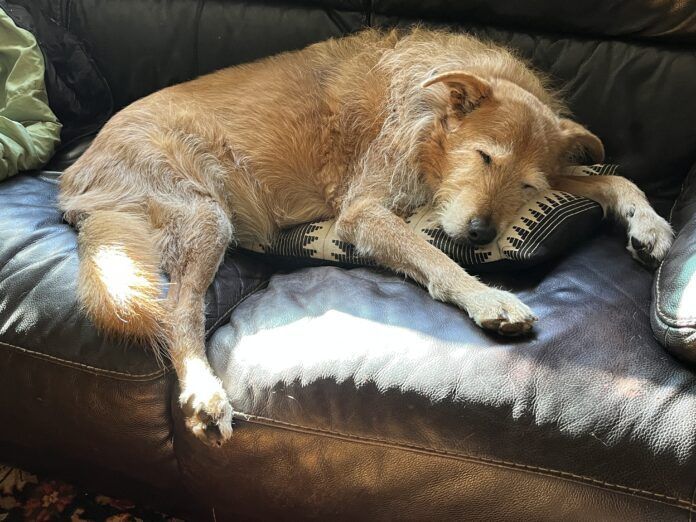
Last September, I thought we were at the end of life for my 15-year-old dog Otto. His arthritis pain is severe, and his daily NSAID and gabapentin was not keeping his discomfort at bay. Thinking he had not long to live, I made an appointment with a housecall veterinarian who specializes in hospice care and at-home euthanasia, who suggested that we increase his dose of gabapentin and add tramadol, an opiate pain-reliever, to his medication regimen.
The tramadol definitely improved Otto’s comfort and mobility. He doesn’t look fantastic – walking behind him as his back legs wobble and partially buckle sometimes is alarming – but he’s happy, still demanding to go for (short) walks with the other dogs, and climbing laboriously onto and jumping off of our couches at night. The medication is definitely worth the hassle of obtaining it.
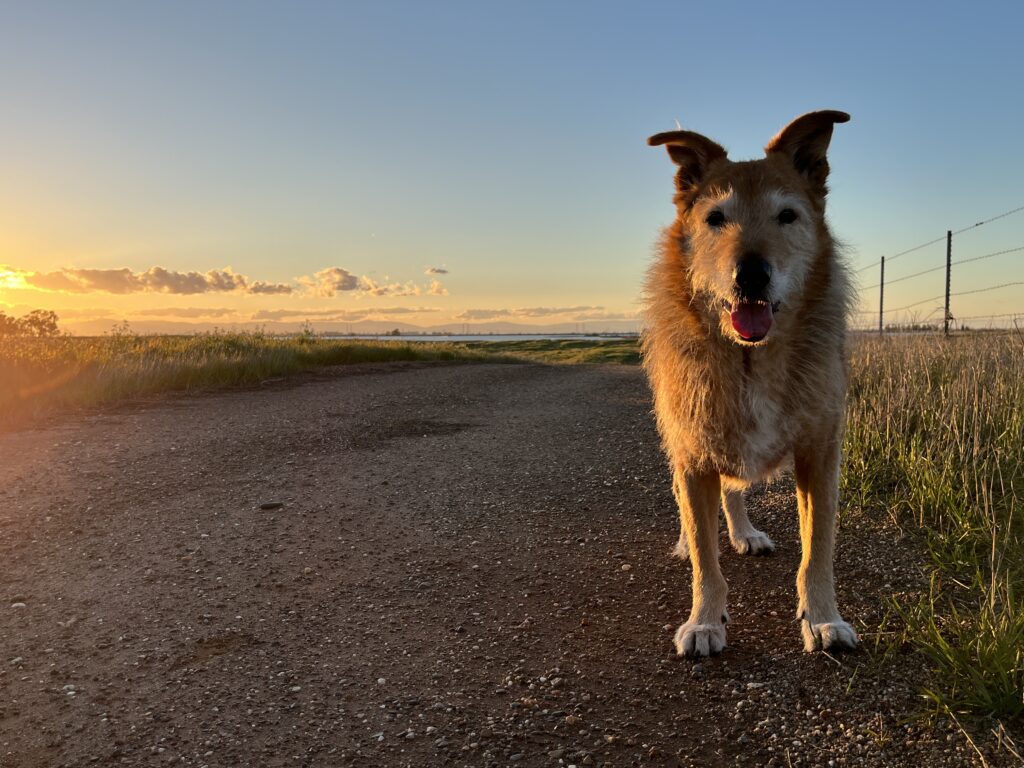
And yes, it’s a hassle. Because it’s a Schedule IV drug, the veterinary hospital that prescribed it cannot dispense it for at-home use (though they keep it in stock and administer it to hospitalized patients); the vets are concerned that humans may take the drug that’s meant for their pets. Instead, the vet calls one month’s worth of the prescription (no more) into a human pharmacy, where I have to show my identification to pick it up. And I can’t call ahead too soon, because the pharmacy will only allow me to have so much on hand. This got a little dicey a couple months ago when I had to pick up the medication the day I left for a six-day vacation to make sure Otto did not have to go without the medication toward the end of my trip.
At the six-month anniversary of Otto being put on this drug, I had to make an appointment with his vet in order to continue receiving it. A dog can’t go more than six months without a veterinary examination in order to receive it. This was fine, though; it gave both me and the vet an opportunity to marvel at Otto’s stubborn refusal to throw in the towel on this painful but still apparently enjoyable life.
Recently, though, we ran into a bigger problem: the challenge of getting the drug at all.
When I called the vet clinic to ask them to call in Otto’s prescription this month, I got a call back from the veterinary pharmacist. He told me that he tried to call in the prescription to the pharmacy at Costco, like he does every month, but was told by the Costco pharmacist that there is a national shortage of the drug. The Costco pharmacist said the store is prioritizing human patients until they can get more, hopefully in a few weeks. The veterinary pharmacist called me to ask which alternative pharmacy he should call the prescription in to.
Here’s the thing: The first month that Otto was prescribed the drug, and the veterinary pharmacist asked me where I wanted to pick up the prescription, I just named the first pharmacy whose name popped into my head: CVS. When I went to pick up the medication, the CVS pharmacist warned me that it was expensive, $120; did I still want it? I was surprised; I hadn’t been aware it was that costly, but I wanted to obtain the medication and see if it really helped Otto, so I paid that amount. When it clearly reduced his pain and increased his mobility, I started calling other pharmacies to see if I could find a better price elsewhere.
Were you aware that drugs cost wildly different amounts, depending on where you buy them? My next call was to Costco, where the same prescription that costs $120 at CVS costs $10. TEN DOLLARS! Unreal.
But now Costco won’t fill the prescription – temporarily, I hope. So I called all five other pharmacies in my town (already knowing CVS charges $120). The supermarket pharmacy quoted me $77. Walgreens charges $90. Neither Walmart nor Rite-Aid would tell me what they charge for that drug; they don’t give out prices for any controlled substances! The pharmacist at Rite Aid also told me that they, too, are prioritizing human patients, and won’t fill a prescription for a pet right now – but the nice person did recommend the little family-owned pharmacy in town that I forgot even existed. When I called that pharmacy, I was quoted $59, and that they would fill a prescription for a dog, at least this one time. (They also mentioned the shortage of the drug.) Whew! I gave the pharmacy information to the veterinarian’s pharmacist and was able to pick up Otto’s prescription later that day.
I’m happy to learn that tiny, independent pharmacies can (apparently) earn a living charging less than the giant chain pharmacies for life-improving or life-saving medications. But I hope that the shortage of this effective medication ends quickly, and that I can buy the drug for Otto at Costco again next month. And I hope that my story of price-shopping Otto’s daily medication inspires you to check the prices for your dog’s daily medications.
Teach Your Dog to “Leave It” and “Drop it”

There’s probably not a companion dog on earth who hasn’t coveted or grabbed something he wasn’t supposed to have, or worse, that could harm him, such as a dropped prescription pill or packet of rat poison. Teaching your dog to happily “Leave it” or “Drop it” might not just save that expensive pair of shoes, a beloved keepsake, or your child’s favorite toy, it could also save your dog’s life!
How to Teach “Leave It”
We use “Leave it” when the dog gazes at – or heads toward – something we don’t want him to have or interact with. When your dog is intently eyeing a tempting deer, or the tasty steak that fell on the floor, a well-taught “Leave it!” cue can save the day.
- Start by saying, “Leave It!” cheerfully (remember, it’s a cue, not a command!) as you hold up a treat, then place the treat on the floor, under your foot to protect it. Allow your dog to sniff, lick, and/or nibble at your show as he tries to get the treat.
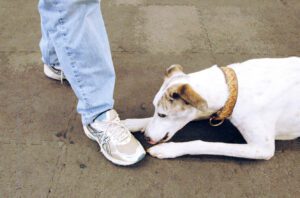
Start by putting a delicious treat (we used a jerky treat) under your foot (wear sturdy shoes!) and allow your dog to try to get it, by licking or scratching. The moment he moves away or looks at your face instead of the treat, mark the moment with a click or “Yes!” and give him a different treat. Photo by Nancy Kerns - The instant he stops sniffing or licking, or looks away, even if it was by accident (say, he heard a noise in the next room), mark that moment (with the click of a clicker or a verbal marker such as “Yes!”) and give him a treat.
- Keep repeating until turns his head away from the treat or looks at you when he hears the cue, “Leave It!”
- When he’s getting the hang of it, move your foot away from the treat slightly to expose the treat as you use the “Leave it!” cue. When he moves away from the treat, use your marker (click or “Yes!”) and give him a treat multiple times to reward him for staying away from it.
- If he dives for the food, just cover it with your foot again to prevent him from getting it. Mark and treat when he looks away. Do not verbally correct your dog; just wait for the desirable behavior of resisting the food, and mark and reward this with a treat.
Remember to say “Leave It!” just one time as you place the treat on the floor; do not repeat it if your dog goes back for the treat – just cover it with your foot to protect it, wait for him to move away or look away, then mark and treat. Practice until he’ll leave anything alone when you ask him to.
Drop It/Trade

Use “Drop it” or “Trade” after your dog already has something in his mouth that you don’t want him to have. Again, a well-taught cue can save the day. We prefer “Trade” over the more common “Drop it” as it implies a cooperative interaction.
- To start, give your dog a toy that he likes. When he’s happily playing, offer him a treat. As he drops the toy to take the treat, say “Trade,” then mark and feed him the treat.
- Keep feeding treats from one hand while you pick up the toy with the other so he doesn’t race you for it. Toss the toy for him to play with and then “Trade” again.

Say “Trade!” and offer him a tasty treat. If your treat is yummy enough, like Tito, he will likely drop the toy and take the treat. Don’t try to race your dog to get the toy, but continue to feed him treats away from the toy so you can casually pick it up. Then throw it for him and start over. Photo by Nancy Kerns - When he trades easily, use a higher-value item such as a food-stuffed Kong. As long as you have a treat that is very high-value, he’ll want to trade, and is unlikely to try to guard his item. (If he does guard his item and isn’t interested in trading, see “Resource-Guarding in Dogs: What You Need to Know.”) Remember to always give the item back to him promptly, so he doesn’t think “Trade” means he’ll lose his good thing.
- On the rare occasion he has something he shouldn’t, play “Trade” exactly the same way – just don’t give it back afterward.
Why Are My Dog’s Nails Splitting?
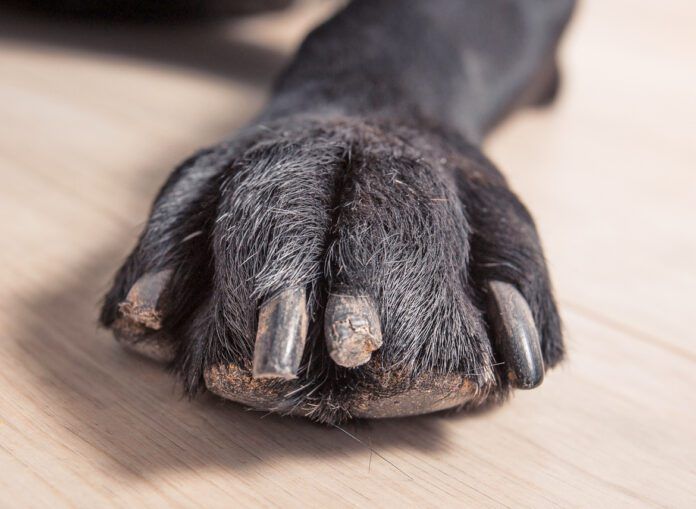
Dog nails splitting, tearing, peeling, or breaking can occur at any age, and they’re no fun for dogs who limp in pain, bleed, lick, or chew their damaged nails, or simply hurt. Split nails disrupt a dog’s coordination, interfere with walks and play dates, and can become infected. For an overview of the best treatment of nail splits and infections, see “Broken or Split Nails,” WDJ December 2022. Here’s how to help prevent this problem from happening in the first place.
Keep those nails trimmed
Too-long nails can become brittle and prone to injury, including snags on carpets, furniture, and other surfaces. Long walks on surfaces that wear the nails down, regular trips to the groomer, and learning how to use clippers or a Dremel rotating nail grinder all help prevent splits. See “The Importance of Trimming Dog Nails,” WDJ April 2016.
Prevention through nutrition
Nails take four to six months to grow, so upgrading your dog’s diet won’t produce overnight results. Be patient, though, because nutrition is a proven long-term strategy. As Amelia White, DVM, DACVD, explains in “Why are my dog’s toenails breaking?” (VETzInsight, June 2018), “The most common reason your pet’s nails are too brittle is that there is a nutritional deficiency somewhere.” The following changes to the diet and/or supplements can help prevent your dog’s nails from breaking and splitting.
- Improve your dog’s protein sources. As canine nutrition expert Mary Straus (dogaware.com) explains in “10 Healthy Additions to Your Dog’s Dry-Food Diet,” animal-source protein such as eggs, meat, fish, and dairy products support the immune and central nervous systems, contribute to wound healing, help build lean muscle, and are required for skin, coat, and nail health. In general, added foods should represent only a small portion of the calories your dog consumes. “Replacing more than 25% of the calories from a commercial diet with fresh foods, treats, and chews risks seriously unbalancing the overall diet, unless care is taken to balance the added portion,” she says.
- Use biotin to strengthen nails. Biotin (Vitamin B7) supplements are given to dogs to treat thinning hair, brittle nails, scaly skin, skin lesions, a dry and dull coat, and hair loss.
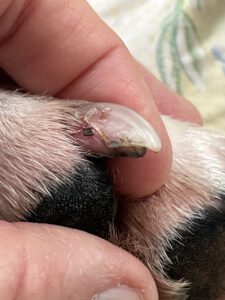
A natural way to correct a biotin deficiency is with foods that contain it, such as liver, kidneys, and other organs from beef, pork, or lamb, and poultry organs or eggs. However, as Straus notes, the low amounts of biotin in fresh foods are less likely to improve skin, coat, and nails than supplements can.
Straus says, “For dogs with minor issues, I would add fresh foods (organs and eggs) to the diet, or consider a B-complex supplement. For dogs with severe nail problems, I would consult a vet to rule out other causes and then, if biotin was appropriate, try megadoses for at least 6 months.”
Daily megadoses were used in one small study (pubmed.ncbi.nlm.nih.gov/2602924/) that found the supplement helped more than 90 percent of dogs with skin and coat problems. The dosage used worked out to 1.5 mg for a 10-pound dog, 3 mg for 25 pounds, 5 mg for 50 pounds, and 9 mg for 100 pounds. Straus recommends using human-grade biotin-only supplements.
- Fish oil can help nails. Fish oil is best known as an effective treatment for canine arthritis, but it is also recommended for brittle, broken nails. Fish oil’s omega-3 fatty acids contain eicosapentaenoic acid (EPA) and docosahexaenoic acid (DHA), both of which are associated with canine skin, coat, and nail health.
In a small 2014 clinical trial reported in the Swedish journal Acta Veterinaria Scandinavica, dogs with symmetrical lupoid onychodystrophy (SLO) were treated either with the immunosuppressant drug cyclosporine or with fish oil that provided 35-40 mg EPA+DHA per pound of body weight once daily for six months. The study concluded that cyclosporine and fish oil appeared to be equally effective.
Most fish oil is manufactured from cold-water fish such as salmon, sardine, or anchovy. Introduce fish oil gradually so your dog tolerates it well, using an amount of fish oil that provides 10 mg of EPA+DHA combined per pound of body weight daily for healthy dogs, or up to 30 to 40 mg per pound for dogs with health issues.
To assure quality in sourcing and manufacturing, look for certification seals from the National Animal Supplement Council or the International Fish Oil Standard.
- Collagen supplements might help, too. Collagen, the main structural protein found in skin and connective tissues, determines the strength and elasticity of hair, bones, nails, and teeth. As dogs age, their capacity to produce collagen diminishes, making them more susceptible to injuries, painful conditions of the bones and joints, and poor skin, coat, and nail health.
Lost collagen can be replaced through supplementation, which can help a dog restore and maintain healthy, moisturized skin, a soft and shiny coat, and strong nails that don’t split or crumble as they grow. Fresh animal proteins contain collagen as do bones and tendons. Giving your dog bones to chew or feeding bone broth can help, as can collagen supplements, which are widely sold. The recommended daily dose for dogs is 8 grams of collagen per 25 pounds of body weight.
Skip the Super Glue and brush-on nail hardener
Nail-hardening products designed for human use are not recommended for your dog’s nail splitting, and neither is Super Glue, which can cause swelling, pain, burning, and infections if applied to split or broken nails.
Moisturize toes to strengthen nails
Conditions like cold weather, low humidity, and exposure to salt and ice-melting chemicals make winter a difficult season for canine nails, so do what you can to protect your dog’s feet when it’s icy outdoors.
Products that protect a dog’s paws like Musher’s Secret and similar combinations of natural waxes and oils help prevent nail splits by moisturizing nails and reducing brittleness. Check your natural foods market for herbal salves that contain calendula blossoms, horsetail (shavegrass) herb, or myrrh essential oil, all of which are nail-friendly and safe for canine application. Every day or two, massage a salve or moisturizing product into your dog’s paw pads, nails, and the base of the nail bed. In addition, see “Savvy Salves” for do-it-yourself products that can keep your dog’s nails strong and supple.
If your dog suffers repeated split or broken nails, schedule a checkup, because the underlying cause might be a fungal infection, inadequate nutrition, an autoimmune disease such as pemphigus or lupus, allergies, ringworm, bacterial infections, endocrine disorders, or symmetrical lupoid onychodystrophy (SLO), an infection that begins in the dew claw nail bed and affects toes with pain, nail splitting, misshapen and disintegrating nails, and nail loss.
Keep track of each broken or split nail your dog endures by making a note on your calendar; if he has more than two in a year, it’s a good idea to discuss this with your veterinarian.
Older dogs, active and athletic dogs, and dogs with weak or long nails are potentially at risk for nail splits.
Genetics play a role, too. According to Auburn University professor and veterinary dermatologist Amelia White, DVM, DACVD, breeds predisposed to autoimmunity-caused nail breaking include the Boxer, German Shepherd, Golden Retriever, Greyhound, Labrador Retriever, Miniature Schnauzer, Rottweiler, and Siberian Husky. Breeds associated with allergies that cause dogs to chew and break their nails include the Golden Retriever, Terriers, German Shepherd, Bichon Frise, and Maltese.
Is Hand-Feeding Your Dog a Good Idea?
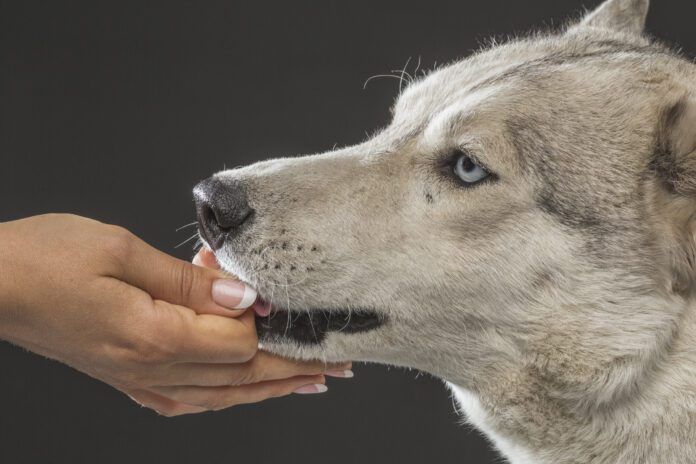
Many trainers feed very little of their dogs’ daily ration from a bowl, but instead, hand-feed the dog’s meals to him over the course of the day. Every interaction with a dog is an opportunity for training. Setting aside a portion (or all!) of your dog’s morning and evening meals and delivering that food by hand throughout the day as your dog complies with requests, along with catching your dog in the act of being good, helps drive up your rate of reinforcement and builds value for the behaviors you’d like to see more often. Hand-feeding is also a great way to help a puppy consistently practice basic skills (such as sit, down, wait, come, etc.) and overall polite behavior.
In addition, for dogs who are generally confident but who have many interests, of which you are just one – in other words, dogs who are easily distracted – hand-feeding for a period can help increase the dog’s attention to you as the handler by associating you with meals and feeding.
Hand-feeding can help establish a relationship between you and a new dog, or your dog and a new person in your life..
When is hand-feeding not a good idea?
While hand-feeding can be used to help establish a relationship with a dog, when used with particularly shy and fearful dogs, it can cause additional stress. Similarly, some people will try to use food or treats to build a fearful dog’s comfort with strangers. The hope is that the dog will associate the presence of the “scary person” (“Yikes!”) with the presence of the food (“Yum!”), but what often happens (especially with dogs who really like food), is that the allure of the food temporarily overrides their unease about the person – but only for as long as it takes to grab the food. Once the food is in their mouth, they instantly realize the “scary person” is too close for comfort. In this case, the food is more of a trap than a tool to help change the dog’s association.
A better approach in the case of the “strangers are scary” problem is for the owner to deliver food in the presence of the “scary person” while the person is noticeable, but far enough away so as not cause significant concern. Take a similar approach if you are trying to use food to bond with a highly fearful dog, by being close enough to him that he associates your presence with the food, but not so close that it takes a major act of courage (or desperation) to eat it.
What to watch for when hand-feeding a dog
Hand-feeding can increase some dogs’ lack of self-control around food. Many dogs are overly excited by food and may jump up or lunge at their owner’s hands as they attempt to get the food. To help teach impulse control in this situation, ask your dog to sit and hold a piece of low-value food in your open palm. Attempt to move your palm closer to your dog. If he moves toward the food, close your fist and, if needed, ask him to sit again. As your dog can control himself as your food hand gets closer, use your opposite hand to deliver food to his mouth and invite him to “take it!”
“Self-control” will look different for different dogs. For especially excitable dogs, self-control might initially mean she holds a sit for two seconds while your open hand is 12 inches above her head. If your dog tends to jump on you when you have food, use a leash to tether her to a sturdy object and stand just beyond the length of the leash. With consistency, your dog will learn the fastest way to get the food is to exercise patience around the food.
If your dog bites down too hard when taking food from your hand, try these tips.
What about dogs who only eat when hand-fed?
In some cases, a dog will get used to being fed by hand and might balk at eating from a bowl. In such cases, a little “tough love” might be in order. Present your dog’s meal in a bowl and give him five minutes to eat. If he doesn’t, pick up the bowl and try again later. A healthy dog won’t starve himself when food is available, even if this technique means he skips a few meals while he waits to see if you’ll revert to feeding by hand.
How Far Can I Walk My Puppy?
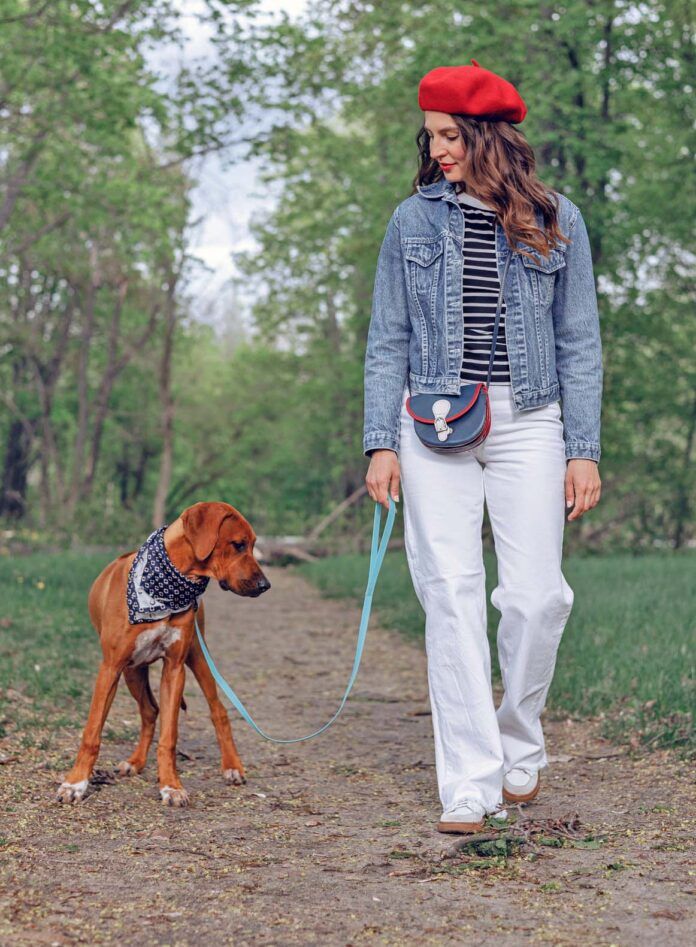
For a new puppy who is about 8 weeks old, keep walks to 5 or 10 minutes. Let your puppy choose the speed, and take breaks as needed. If she is tired and doesn’t want to walk, carry her home.
As your puppy gets older, she can gradually take longer walks. A 12-week-old puppy can walk about 15 to 20 minutes. Again, allow your puppy to choose the speed and take plenty of breaks for sniffing. Avoid trying to pull the puppy.
Puppies are still developing their muscles and bones, so long walks can be too hard on their bodies. If you must walk on pavement, keep walks shorter. Walks on grass or dirt are easier on your puppy’s growing bones than pavement.
Increase Walks as Puppy Grows
By 16 weeks of age (4 months old), most puppies can go for 30-minute meandering walks. Increase the time to 45 to 60 minutes as your puppy reaches 6 or 7 months of age.
Hold off on true hikes or long purposeful walks on pavement until your puppy has physically matured.
Long Walks Stress Puppy Bodies
Your puppy’s bones are still growing. She will become physically mature at around 12 months of age for small dogs and around 18 to 24 months for larger dogs. Puppy bones have soft “growth plates” at the ends where new bone is produced as the puppy grows. The growth plates are not as sturdy as mature bone, so they are easier to damage. Even worse, an injured growth plate can cause the bone to stop growing early. This can result in lifelong orthopedic problems.
Free Run Instead
The best exercise for puppies is safely free running. Let your puppy choose her own adventure and play at her own pace.
If you have access to a fenced yard, allow your pup to wander freely, choosing her speed and direction. Stay with her! She will naturally regulate her activity, going fast when she wants to and slowing down when she gets tired.
If you don’t have a fenced yard, let your pup play on a long line of around 15 feet for young puppies in a safe space. Hold the end of the line while she plays, keeping it slack as much as possible.
Longer Walks Will Come
It can be tempting to take your puppy for a long walk to wear her out but resist the urge. Instead, treasure these meandering strolls while her body grows and matures. Try to see the world through your puppy’s eyes and enjoy her antics as she zigzags around the yard and explores her world. Let her learn about the world.
Leave your puppy home and take your older dog or go for a solo outing when you want to take a more purposeful walk and cover ground. When your puppy has matured, you’ll have plenty of time for hikes and long walks, and those healthy joints you nurtured when your dog was a puppy will last a lot longer.
Dry Shampoo for Dogs
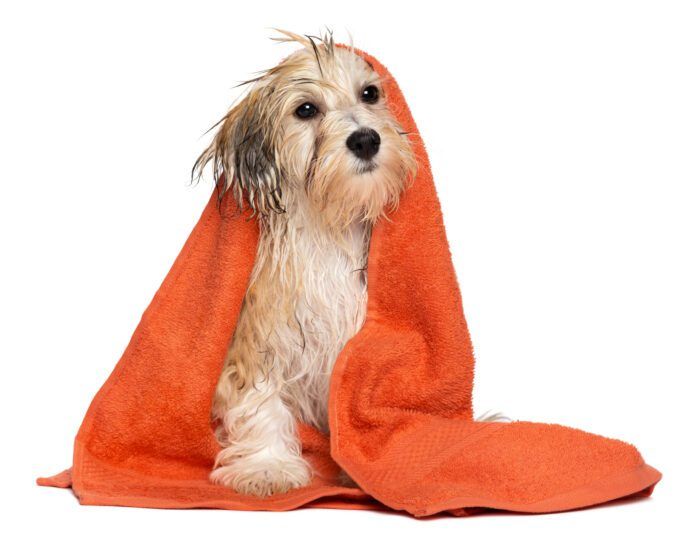
If your dog sort of, well, stinks and you don’t want to give a real bath, you may ask yourself, “Can I use dry shampoo on my dog?” The answer is simple: Yes, you can use dry shampoo on your dog. The bigger question is, “Should you use dry shampoo on a dog?”
Dry shampoos for dogs, also known as waterless or no-rinse shampoos, deodorize your dog—and that’s about it. So, while these products may help in a pinch with an odor, they don’t clean your dog. You’re not truly removing any of the dirt from the dog’s skin. The dry formulations may absorb some of the excess oils in your dog’s coat, but your dog will not look freshly bathed. He won’t be shiny and bright with a glossy, flowing coat. He’ll just smell better for a while. Maybe.
How to Use a Dry Dog Shampoo
Most dry shampoos are not powders that you sprinkle on your dog. They’re foams or sprays you work into the dog’s coat, like human hair mousse products.
The word “dry” refers to the fact you don’t need water. These products are not a whole lot easier to use than a real shampoo, except, of course, you don’t need to rinse. You also generally still must towel-dry the dog, or if you did choose a powder dry shampoo, comb your dog’s hair. Dry shampoos are not time-savers!
Choosing a Dry Shampoo for Your Dog
We don’t recommend dry shampoos, but if you insist on using one, there’s one main thing to avoid: Don’t buy any product that’s delivered in a container that uses a propellant. Personal care products that come in cans, including human hair mousse and pet dry shampoos, often contain petroleum distillate propellants like propane or butane. And benzene, a cancer-causing chemical, is a common contaminant of petroleum distillates. Powdered or manual pump-spray products are safer.
Choosing a product formulated for dogs is an absolute must. Look for dry shampoos for dogs that contain only natural ingredients that help deodorize your dog. (Remember, regular shampoos are only on the dog’s coat for a minute or two and then thoroughly rinsed away; dry stuff stays in the dog’s coat until you give him a real bath or he goes swimming.)
Still, we advise you to only use a dry shampoo when there’s no other choice because, really, there are no shortcuts for a good, healthy bath.
Sick? Or Psych?
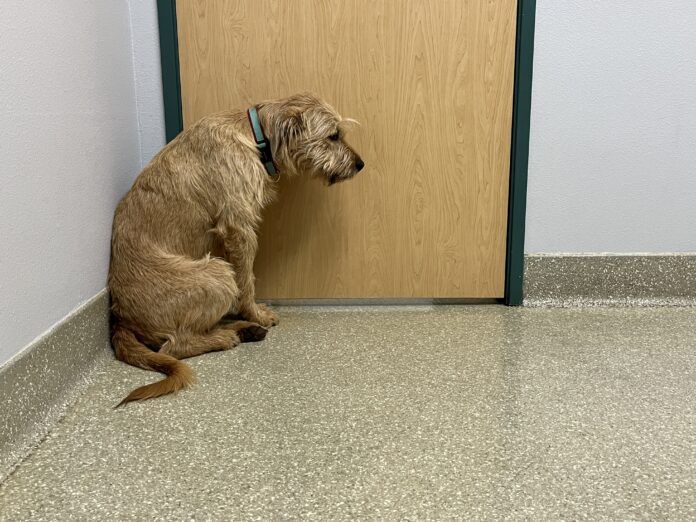
The first thing that didn’t seem right when I woke up at around 6 am was that Boone was not asleep on the dog bed that’s in my bedroom. He’s the only one of my dogs who has decided that he would rather sleep near me than on one of the couches or the giant Snoozer dog bed in the living room. But last Thursday morning, he was not in his regular spot.
I got up and went looking to see where he might be – just curious, not worried. He can sleep wherever he wants! I found him curled up on the Snoozer – odd, but not unthinkable. I greeted all three dogs, and opened the front door so they could go outside and pee. But only my two older dogs got up to go outside. Now, that IS weird. Fifteen-month-old Boone is usually jamming his nose in the gap between the door and the frame, cramming his body outside before anyone else. He loves being the first dog outside, so he can joyously race across the lawn, hoping to surprise an unwary squirrel on the ground and make the robins fly. But on this day, he stayed curled up, just looking up at me with his eyes, not even raising his head. “Hey buddy,” I said to him. “What’s up with you?”
I grabbed the dog bowls and headed over to where I keep the dog food. This was the big test, because Boone always – and I mean always – accompanies me to fill the dog bowls. He watches my every move, hovering near the bowls. He doesn’t help himself to the food I measure out, but gets to grab for and scarf up any stray kibbles that hit the ground as I scoop and pour the food into the three bowls. But on this day, he stayed on the dog bed as I prepared the dogs’ meals.
I called Boone over to me. He got up very stiffly, noticeably limping on his right front leg. His head was down. When he stopped walking, he stood in a strange stance, with his right front leg turned at a weird angle. He looked miserable.
I sat on the floor in front of him and did a quick exam. Did he have a cut on his paw, a thorn, a broken toenail? No. Did he have any cuts or scrapes? No. Did he flinch when I pressed and flexed the various joints in his ankle, elbow, or shoulder? Also no. But when I got up and asked him to follow me outside, he moved very stiffly and slowly, not at all like his usual bouncy self. I watched as he urinated – it seemed like the usual color – and then asked him to come back into the house.
I went straight back to my bedroom and got dressed. The closest emergency veterinary hospital is about 30 minutes away and they open at 7 am. If I left right away, we could be there within a few minutes of opening and stand a chance of getting seen before 10 am. I don’t know what was wrong with him, but given that this was on a Thursday before a holiday weekend, I didn’t want to take any chances. As I drove, I thought to myself that I should have taken his temperature before I headed to the vet, but on the other hand, then I wouldn’t be close to first in line at the ER.
My plan paid off; I wasn’t first, but was among the first people there, and they had an opening. We were in a room by 8 am. A technician took his vital signs – and he had a normal temperature. Whew! That ruled some things out. But Boone was definitely not himself. Instead of checking out the room or bugging me for attention and petting, he sat across the room from me, leaning on the wall, head down. When I told him to lie down, he ignored the cue and continued to sit.
When the doctor came in, Boone greeted the doctor in a very low-energy way. The doctor noticed his limp and his strange stance. The doctor also listened to his breathing and heart and palpated his abdomen, but said, “His posture is weird. I wouldn’t be surprised if he hurt his elbow, the way he’s standing. But I’d like to take him in the back and lay him on a table, to rotate and move his shoulder and elbow. And we might need to take some x-rays – but I’ll let you know.”
Within 10 minutes or so, the doctor was back. “Boone didn’t have any trouble with flexing or rotating any joint,” he said. “It’s weird. While it’s possible that he has a hairline fracture or something, I think it’s more likely that he strained or pulled something. I’d like to send him home with some carprofen (an NSAID); let’s see if this resolves in a couple of days of rest – and if it doesn’t, bring him back and we’ll take some x-rays.”
But as the doctor was talking, I was looking at Boone, who was again sitting and leaning against the wall, head down, eyes half-closed. “I feel like there is something else going on!” I said. “This is usually a very energetic 15-month-old dog! Look at his eyes! He’s closing them! He just looks so dopey!”
The vet sort of cut me a look at that last phrase. Until I spontaneously said the word “dopey,” I hadn’t even considered the possibility of Boone having ingested something intoxicating – mostly because neither my husband nor I use any form of cannabis, nor any other type of opiate or medication. I hastily added, “We don’t have any dope on the property! There’s absolutely nothing to get into – no medications, no recreational drugs, nothing!”
“He does seem awfully subdued,” the vet said. He checked the chart, and asked the technician about Boone’s temperature. “It was normal?” he asked. “And you got a good temp, no messing around?” She assured him that she had the thermometer all the way in for the full length of time – that the reading was good.
I asked about various issues that were caused by tick bites (such as tick paralysis) or carried by ticks (such as Lyme disease or anaplasmosis); I had walked Boone and Woody the day before in a particularly tick-infested area. However, I hadn’t let either dog off leash (because we kept spotting deer) and we were walking on a wide dirt road – not many chances to come into contact with the brush or grass that ticks are generally waiting on. And I hadn’t seen any ticks on either Boone or Woody the night before. The doctor said that tick paralysis affects the back legs first – a limp in the front ruled that out. And while a limp could be a sign of a tick-borne disease, a limp that moved from one limb to another (because all the dog’s joints were painful) was more classic – and the dog would most likely have a fever. He said, “It might be helpful to run some blood tests, to see if anything is out of the ordinary. We can check for tick-borne disease, and he’s due for a heartworm test. Let’s get all that, give him the carprofen for a few days, and see where we are after that. But of course, bring him back if he gets worse!” I agreed; maybe the test results would shine some light on this strange, nonspecific malady.

I drove home, and offered Boone the chewable carprofen. I was heartened when he ate it readily, as well as the breakfast that he hadn’t been interested in earlier. But not long after that, he went back to the Snoozer dog bed, and resumed sitting in that weird position, head down, eyes closing. And when I told him to lie down, he again ignored me. He didn’t want to lie down for some reason. We had been home for about 45 minutes when I called the vet again, asking if I could bring Boone back. The receptionist said they could see him again at 12:30. We had to wait 2½ hours – but at least they could see him.
Fortunately, over the next couple of hours, Boone began perking up. When we went out to my office, he went into the big soft crate with the other favorite dog bed in our home, the Wash ’N’ Zip Pet Bed, and lay down, instead of continuing to sit in that strange pose. And when I went to get some coffee from the house, he volunteered to come with me, and it looked like he wasn’t limping as much. Could the carprofen be working that quickly, I wondered? After I got my coffee, I walked around with Boone outside until he went poop; I was relieved to see that it looked normal.
By noon, he was back to sitting in front of my office door looking through the glass like he normally does. I called the veterinary hospital and told them I was sorry for the inconvenience, but that I would not be bringing him back after all; it seemed like he was feeling better.
By that evening, Boone was behaving 100% normally – normal energy, normal appetite, normal gaits (no limp whatsoever). And he’s been fine ever since. What the heck?!
The next day, the vet called to report that all Boone’s blood values were normal, he was heartworm negative, and his tick-borne disease titers were negative.
I’m thrilled that nothing more seems to be wrong with my young dog, but I’m still mystified as to what all that could have been about, and concerned that something is lurking and might resurface. He looked seriously ill for a couple hours – and his limp was not in my imagination; everyone saw it. Did he just have a sprain, and was being the world’s biggest wimp about it? Could he have eaten something intoxicating that someone had thrown over the fence – and the limp was a coincidence? The vet said he didn’t show any signs of discomfort in his gut, but his strange posture and reluctance to lie down made me feel like something was uncomfortable in his tummy. Unless any of these symptoms recur, I’ll never know.
Scent Games for Dogs
Scent games for dogs are sweeping the canine nation at home and in competitions because they’re just so much fun. Any dog can play scent games, and it doesn’t take a lot to set up a game.
The world is a treasure trove of scents for dogs. Scent is a natural way for them to sense the world and to be enriched. That’s why we encourage you to let your dog sniff when you go on walks together. It’s how he gets his news! A dog’s ability smell things is an important part of being a dog.
Because a dog’s sense of smell is so much better than ours, it is easy to get them in the spirit of nose work type games. From puppies to seniors, dogs love to smell and find the prize.
Home Scent Games for Dogs
The easiest way to start with scent games is to use food treats. Hide a treat in a box or put a treat under a cup along with two empty cups (yes, like the old “shell game”) and then let him find it.
You can make a simple food puzzle at home by hiding some treats in a muffin tin, then covering the holes with tennis balls. Of course, ball-loving dogs may quickly grab the ball and run off, not even realizing there’s food, so you may have to “explain” it to him at first.
You can also hide a treat or a favorite toy in one room and then let your dog in to search. Dogs just naturally pick up on these types of games. You may even be able to make your own dog scent toys.
Dogs love these activities, and scent games have low risk for physical injury, so they are great for puppies and seniors. These games are also good for dogs who are confined due to illness or recovery.
Scent Work Competitions
If you want to participate in formal canine scent sports, more training is required, but this sport is growing quickly for good reason—dogs and handlers both enjoy the tests.
These scent games tend to use essential oils for the scents, starting with birch oil for the lowest levels. You start by giving your dog a positive association with the scent, pairing the scent with a treat. Dogs quickly figure out that if they indicate where the scent is they will get a great treat or some tug play if they prefer that.
You can move on to hiding the scent indoors, outdoors, in containers, or even buried in sand or water. At the beginning levels, only one scented “hide” is in a search area. Additional scents are later added, such as anise and clove, so the dog must find more than one scented object.
To find a dog scent work instructor in your area, go to the National Association of Canine Scent Work.
Is Your Dog’s Poop a Weird Color?
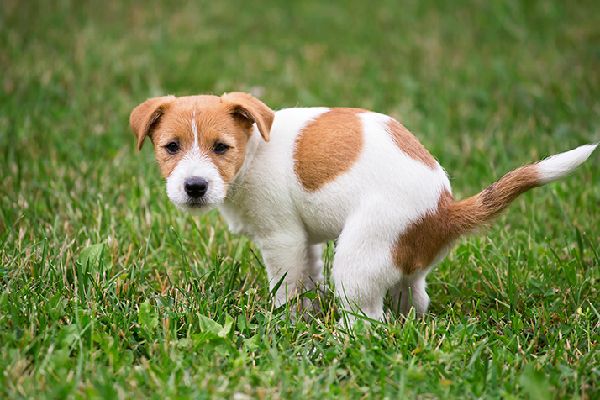
We have all heard the old adage, “You are what you eat.” The same can be said for our dog’s poop and its color. If your dog munches on grass or you add canned pumpkin to one or more of his daily meals, these additions can cause green or orange poop. But there are times when poop that isn’t brown may be an indication of an underlying health issue. Check the chart below to determine when your dog’s poop color should prompt a visit to his veterinarian. Note that the actual color of the feces won’t exactly resemble that of our PlayDoh facsimiles, but you should get the idea!
Green dog poop: Your dog may have green poop if he has been eating grass or enjoys eating leafy greens, such as kale or spinach. Some dental chews – such as OraVet or Greenies – will turn the color of a dog’s poop light green. A dog who has recently consumed rat or mouse poison might have fluorescent green poop. But a dog who has not eaten anything green recently may have green poop because of a nutrient absorption problem in the small intestine, such as inflammatory bowel disease, protein-losing enteropathy, or intestinal parasites. Make an appointment with your dog’s veterinarian and bring a stool sample to screen for intestinal parasites.

Orange dog poop: Just like with green poop, the pigments present in certain foods can turn a dog’s poop orange in color. This includes foods rich in beta-carotenes, such as carrots, squash, and canned pumpkin. But if these foods are not a part of your dog’s diet, then orange poop may be an indication of underlying gallbladder or liver disease. Make an appointment with your dog’s veterinarian, especially if the orange poop is soft and if your dog is vomiting and not eating.

Yellow dog poop: Yellow poop is not normal and is typically not caused by pigments found in food. Yellow poop that is formed can be an indication of liver or gallbladder disease. Yellow diarrhea is typically an indication of intestinal disease. Your dog needs to be seen by his veterinarian as soon as possible.

Red dog poop: If your dog is one of those rare canines who enjoys eating beets, then the pigment in beets will cause your dog’s poop to be shades of red or purple. But for all other dogs, red poop or red streaks on poop is a sign of disease in the large intestine (colon) or rectum. Your dog needs to be seen by his veterinarian or an emergency veterinarian immediately.

Black dog poop: Black, tarry stool is caused by bleeding in the stomach or small intestine. Your dog should be seen by his veterinarian or an emergency veterinarian immediately. The only time that black poop is normal is if your dog has recently been administered activated charcoal by his veterinarian. Activated charcoal is given to dogs that have ingested certain toxins, like chocolate or mouse poison.

Grey dog poop: Grey poop is always abnormal and is an indication of an issue with your dog’s pancreas. You may also notice greasy poop, diarrhea, and weight loss. Make an appointment with your dog’s veterinarian as soon as possible.

Brown dog poop with white spots: Those little white spots in your dog’s poop may be intestinal parasites, such as roundworm or tapeworm. Bring a stool sample to your dog’s veterinarian and have it tested for intestinal parasites.

Not all non-brown poop is cause for alarm. But, as you can see, some colors may indicate a serious underlying problem. Talk to your dog’s veterinarian if you have any concerns about his poop color.
How Long Should a Dog’s Nails Be?
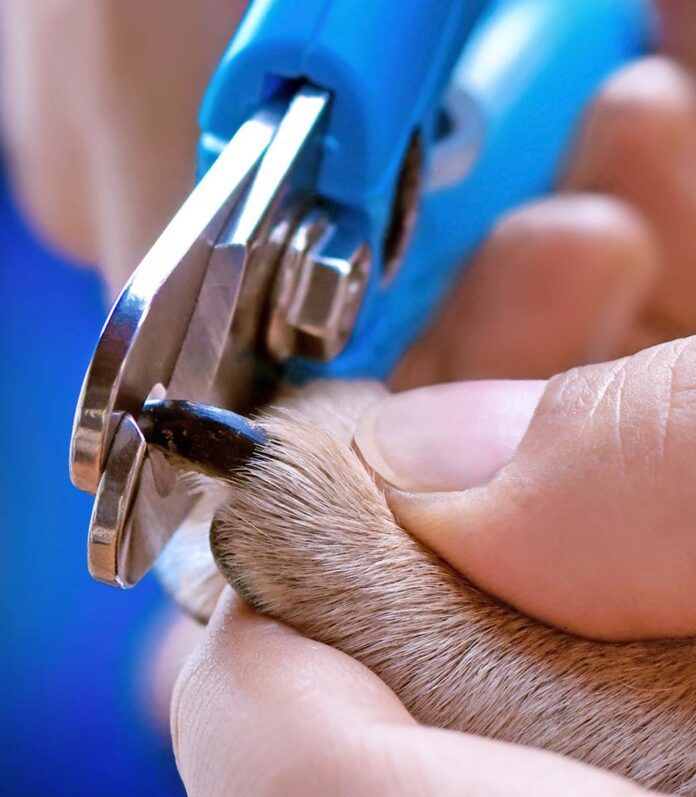
Your dog’s nails provide traction and digging power even when they are short. The longer they get, the higher the risk that they may cause injuries. Nails clicking on the kitchen floor is a signal that it’s past time for a nail trim.
How long should a dog’s nails be? The correct dog nail length is short. Nails shouldn’t touch the ground when your dog is standing still. As your dog runs and flexes her feet on the move, the short nails will still contact the ground to give her a good grip.
Long Nails Can Cause Pain
Dog nails that are too long can impact how your dog walks. As the nail grows outward, it will also curve. A tight curve will eventually curl all the way around and start growing into your dog’s foot pad – ouch! This is painful and can lead to infections.
Even slightly curved nails are problematic. As the nails continue to grow, they gradually curve more and more. The dog’s feet will tip back to accommodate the long nails, changing your dog’s posture. This abnormal stance changes how your dog’s joints line up and can contribute to pain and joint disorders.
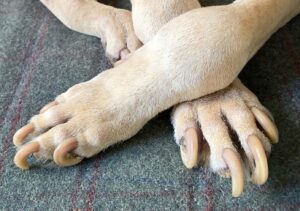
How to Tell if a Dog’s Nails Are Too Long
For many dog owners, nails clicking on the kitchen floor is the signal that it is time for a nail trim.
Another sign may be splayed, flat-looking feet. Some dogs have this conformation naturally, but regular nail trims to get them short over time can help the paw tighten up in some cases.
Nails getting caught in blankets, carpeting, or clothing can also be a sign that they are too long.
Dog Nail Trims Take Patience
You probably won’t be able to get your dog’s nails to their ideal length in one sitting, especially if they have been growing unchecked for a long time. Set a recurring alert on your phone to trim your dog’s nails at least once a week, taking off as much as you can safely each time. For dogs with black nails, just trim a little bit so you don’t have to worry about hitting the quick and hurting your dog.
You can trim your dog’s nails using a pet nail grinder or nail clippers. Trimming a small amount off your dog’s nails frequently will allow you to wear the nails back over time – and then keep them there. If your dog doesn’t like to get her nails trimmed, “A Counter-Conditioning Protocol for Trimming Your Dog’s Nails” offers tips and how to gradually get her to accept this chore.
Why Do Dogs Show Their Teeth?

There are a number of situations during which a dog may show his teeth – and the ones that involve aggression are few. Dogs may bare their teeth as an appeasement gesture (which looks like a sheepish grin), during dog-dog play (perfectly appropriate!), or to communicate discomfort or stress (in which case, you should be careful, because he’s asking for space). While these are all normal dog behaviors, each of these tooth-display scenarios begs a different response from you, depending on the circumstances.
What to do when your dog shows teeth
Determine which of the above is the cause of your dog’s dental display and respond accordingly as follows.
- Appeasement grin: This can happen when a dog feels pressured or intimidated. The majority of dogs never do this – and a very small percentage do it a lot. If you see other appeasement signals (head turn; lowered body posture; body leaning backward, behind the vertical) it’s likely a smile, not a snarl. Relax your own body posture (stop acting so assertive or pushy!), turn sideways, smile, talk softly, and assure your dog he’s not in trouble.
- Dog-dog play: If both dogs enjoy tooth play, let it be! If one seems overwhelmed, give the dogs a cheerful timeout break, and then let them go back to playing. If one is consistently overwhelmed, find each dog new play partners.
- Discomfort or stress: Like the growl, a toothy snarl is a sign of aggression. Like the growl, it’s actually a good thing. It’s an escalation in intensity from the growl, but your dog is still trying very hard to NOT bite you. He’s saying, “You’re making me really uncomfortable; please stop what you’re doing.” So stop whatever is stressing him! If what you’re doing is something that must be done (such as toothbrushing or nail-trimming), take the time to help him learn to be happy about it. (Here’s an example of what to do to improve your dog’s response to nail-trimming. Take the same approach, using counter-conditioning and desensitization, for any procedure your doesn’t currently feel comfortable with.)
Whatever the reason for your dog’s teeth display, never, ever punish him for this. You want him to feel comfortable communicating with you, so you can figure out why he’s showing teeth and take whatever steps are appropriate.




